
Be sure to reflect on your accomplishments and areas of growth!
- Subject:
- Business and Communication
- Psychology
- Social Science
- Material Type:
- Lesson
- Author:
- LAPU
- Date Added:
- 04/14/2023

Be sure to reflect on your accomplishments and areas of growth!
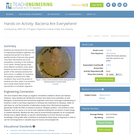
Students are introduced to the concept of engineering biological organisms and studying their growth to be able to identify periods of fast and slow growth. They learn that bacteria are found everywhere, including on the surfaces of our hands. Student groups study three different conditions under which bacteria are found and compare the growth of the individual bacteria from each source. In addition to monitoring the quantity of bacteria from differ conditions, they record the growth of bacteria over time, which is an excellent tool to study binary fission and the reproduction of unicellular organisms.
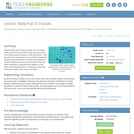
Students learn about various crystals, such as kidney stones, within the human body. They also learn about how crystals grow and ways to inhibit their growth. They also learn how researchers such as chemical engineers design drugs with the intent to inhibit crystal growth for medical treatment purposes and the factors they face when attempting to implement their designs. A day before presenting this lesson to students, conduct the associated activity, Rock Candy Your Body.
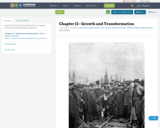
Chapter 12 Growth and Transformation is a chapter from a history book for higher education.

This article describes six collaborative and real data projects that engage elementary students in collecting and sharing local data and communicating with students across the country and world.

This course explores the reciprocal relationships among design, science, and technology by covering a wide range of topics including industrial design, architecture, visualization and perception, design computation, material ecology, and environmental design and sustainability. Students will examine how transformations in science and technology have influenced design thinking and vice versa, as well as develop methodologies for design research and collaborate on design solutions to interdisciplinary problems.

This resource is a video abstract of a research paper created by Research Square on behalf of its authors. It provides a synopsis that's easy to understand, and can be used to introduce the topics it covers to students, researchers, and the general public. The video's transcript is also provided in full, with a portion provided below for preview:
"This is germ cell-expressed protein (GCE). Across the scientific literature, GCE is treated as equivalent to Methoprene tolerant protein (MET) as both are hormone receptors that prevent the premature development of the common fruit fly. But a new study indicates that subtle structural differences between GCE and MET contribute to functional distinctions that should make each protein a unique object of research. These differences lie along the long C-terminal fragments of the proteins, dubbed GCEC and METC. Structural characterization experiments suggest that GCEC is a long, asymmetrical, and coil-like intrinsically disordered protein. Compared with METC, GCEC is less compact, contains more molecular recognition elements, and is more susceptible to folding. That, according to NMR data, enables GCEC to interact with the nuclear receptor FTZ-F1. which can force GCEC to adopt a more fixed structure and different function than METC..."
The rest of the transcript, along with a link to the research itself, is available on the resource itself.
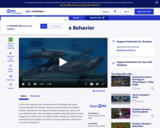
This video segment from the Science and Technology Chat series focuses on dolphin pregnancy, birth, and care of the young, and features Atlantic bottlenose dolphins living in captivity at the Mirage Resort Dolphin Habitat.
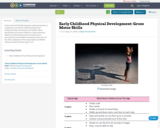
In the study of Child Development, physical growth is a complex process which entails learning about children's bodily movements and abilities. More specifically, gross motor skills are a type of physical abilities in which large muscle movements are exercised by young children during the early years of life. This is glimpse of what typical physical abilities children possess between ages 3 to 5.

As markets or production bases, China and India are becoming important and integral players in the global economy. Foreign direct investment (FDI), portfolio investments and outsourcing businesses have increased dramatically in these two economies. Despite the rising importance of these two economies on the world stage, our knowledge and analysis of these two countries in an integrated manner has remained poor. The two are often lumped together by business analysts as “emerging markets,” despite the substantial differences in their political systems, reform policies and business organizations. Academics, in contrast, have tended to treat the two countries separately, preferring to specialize in issues and questions specific to one or the other country.
The purpose of this course is to analyze these two countries within a coherent analytical framework. Our learning model is inductive, and heavily based on class discussions and participation. The group projects should aim at integrating analysis, knowledge and understanding of these two countries. We will also experiment with other forms of group projects, such as creating and working on business plans and those projects that integrate research from field trips with more traditional research, such as library research. There is no prerequisite but 15.012 (Applied Macro- and International Economics) and 15.223 (Global Markets, National Policies and the Competitive Advantage of Firms) are highly recommended.

This class provides a general introduction to the diverse roles of microorganisms in natural and artificial environments. It will cover topics including: cellular architecture, energetics, and growth; evolution and gene flow; population and community dynamics; water and soil microbiology; biogeochemical cycling; and microorganisms in biodeterioration and bioremediation.

This course explores the proper role of government in the regulation of the environment. It will help students develop the tools to estimate the costs and benefits of environmental regulations. These tools will be used to evaluate a series of current policy questions, including: Should air and water pollution regulations be tightened or loosened? What are the costs of climate change in the U.S. and abroad? Is there a “Race to the Bottom” in environmental regulation? What is “sustainable development”? How do environmental problems differ in developing countries? Are we running out of oil and other natural resources? Should we be more energy efficient? To gain real world experience, the course is scheduled to include a visit to the MIT cogeneration plant. We will also do an in-class simulation of an air pollution emissions market.

This course explores the proper role of government in the regulation of the environment. It will help students develop the tools to estimate the costs and benefits of environmental regulations. These tools will be used to evaluate a series of current policy questions, including: Should air and water pollution regulations be tightened or loosened? What are the costs of climate change in the U.S. and abroad? Is there a “Race to the Bottom” in environmental regulation? What is “sustainable development”? How do environmental problems differ in developing countries? Are we running out of oil and other natural resources? Should we be more energy efficient? To gain real world experience, the course is scheduled to include a visit to the MIT cogeneration plant. We will also do an in-class simulation of an air pollution emissions market.
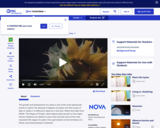
Watching plants grow is like watching paint dry: It happens so slowly that the changes are imperceptible from one moment to the next -- and yet the end results are dramatic. This video segment shows just how amazing plant development can be by depicting various phases of the process using time-lapse photography. Footage from NOVA: "The Shape of Things."

This resource is a video abstract of a research paper created by Research Square on behalf of its authors. It provides a synopsis that's easy to understand, and can be used to introduce the topics it covers to students, researchers, and the general public. The video's transcript is also provided in full, with a portion provided below for preview:
"Autophagy is a critical process in healthy human cells that removes excess organelles and substances while generating energy. But in cancer cells, autophagy can either feed growing tumors—literally supplying energy—or suppress them by clearing out cancer-promoting substances. Recently, researchers examined this process in non-small cell lung cancer (NSCLC) and focused on GNIP1, a TRIM family protein. Other TRIM proteins have been associated with autophagy previously, but this is the first autophagy study to examine GNIP1. GNIP1 expression was elevated in tumor cells from NSCLC patients, and clinically, it was associated with poor prognosis and survival time. Induced overexpression of GNIP1 in cultured NSCLC cells increased the cancerous behaviors proliferation and migration. Additional cell culture experiments indicated that GNIP1 did this by enhancing autophagy. Specifically, GNIP1 mediated the breakdown of the VPS34 complex, an autophagy inhibitor..."
The rest of the transcript, along with a link to the research itself, is available on the resource itself.

This resource is a video abstract of a research paper created by Research Square on behalf of its authors. It provides a synopsis that's easy to understand, and can be used to introduce the topics it covers to students, researchers, and the general public. The video's transcript is also provided in full, with a portion provided below for preview:
"The gilthead sea bream is one of the most important fish farmed in the Mediterranean. Selecting for economically valuable genetic traits has helped improve bream farming efficiency. But little is known about the role played by intestinal microbes in selective breeding practices. To find out, researchers examined how genetic selection for different growth rates and diet affect intestinal bacteria in the gilthead sea bream. Bream were divided into three groups according to genetically selected growth rate: slow, intermediate, and fast, and were fed a plant-based diet, a sustainable alternative for the normally carnivorous gilthead sea bream. The plant-based diet significantly changed the microbial makeup of the slow- and intermediate-growth groups, with a much weaker effect observed for the fast-growth group. And when exposed to an intestinal parasite common to the gilthead sea bream, the fast-growth group showed significantly lower parasite intensity and abundance than the slow-growth group..."
The rest of the transcript, along with a link to the research itself, is available on the resource itself.
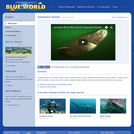
In this video, Jonathan travels to Canada in search of the Greenland shark, a huge, lethargic shark that lives in arctic waters. It takes days of effort, but finally, in dark, cold, murky water, Jonathan finally meets this elusive animal, and it's nothing like he expected. Please see the accompanying study guide for educational objectives and discussion points.

This collection of six images captures the magnificence of human development -- the transformation from baby to woman.
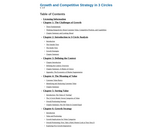
The 3-Circle model was developed over the past several years, initially in strategic planning for a university graduate program and in an executive MBA course designed to integrate the concepts ofmarketing and competitive strategy. Over the course of time, the 3-Circle model has beensuccessfully used by hundreds of organizations throughout the world in establishing and growing their market positions. Many of the case examples in this book demonstrating applications of the 3-Circle model applications are from executives who have attended executive education training at the University of Notre Dame.

This resource is a video abstract of a research paper created by Research Square on behalf of its authors. It provides a synopsis that's easy to understand, and can be used to introduce the topics it covers to students, researchers, and the general public. The video's transcript is also provided in full, with a portion provided below for preview:
"Feed efficiency is an important economic and environmental parameter in raising swine. It captures how effectively livestock feed is turned into food products for humans. Increasing a pig’s feed efficiency can reduce a farm’s costs and energy use. A new study shows that one factor that could affect pigs’ feed efficiency is their gut microbiome. Feed intake and body weight measurements showed significant differences in feed efficiency among three pig breeds: Duroc, Landrace, and Large White, while genetic analyses of their gut microbiomes revealed differences in their microbial makeup. Association analyses between these datasets indicated a positive association between 4 types of bacteria and feed efficiency. This link could help both scientists and farmers understand how intestinal microbes influence animal traits crucial to production. such as those related to fatness. And it could offer a valuable new way to influence the feed efficiency of pigs..."
The rest of the transcript, along with a link to the research itself, is available on the resource itself.